The late Robin Williams was a comedic genius and an avid tennis fan. Robin's quote got me thinking about tennis strategy and tactics.
I read a very interesting article about Boris Becker and other tennis players who use chess to anticipate their opponents moves as well as improve their own offense. After his tennis career ended, Boris played against chess Grand Master Garry Kasparov on Larry King Live on CNN in March 2000. Boris is currently coaching ATP Mens World #1 Novak Djokovic. Novak's game has benefited from improved strategy and holds a nearly 2 to 1 points advantage 16,585 to 8,945 over world # 2, Andy Murray.
I kept reading more about the relationship between tennis and chess. It is closer than what I previously had thought. Hungarian-American physics professor Arpad Elo developed the competitor-versus-competitor ranking system to rank chess players. It is known as the Elo Rating System. Some tennis statisticians have started using chess ranking metrics to rank tennis players. Nate Carter cites a chart in his article titled "No DJoke Novak Djokovic is the greatest tennis player of all time. You just don’t know it yet……"
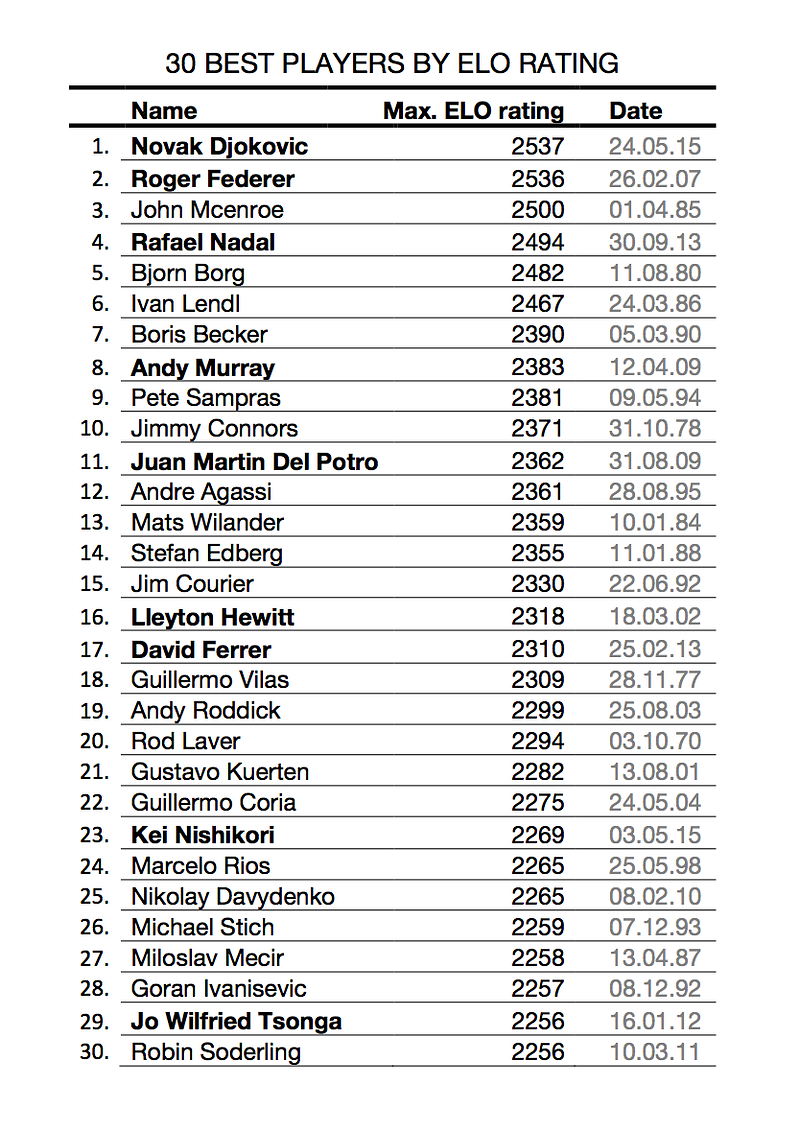
Novak is in some impressive company on all surfaces. Peter Schindler of the Imperial College London wrote a Masters Thesis titled "A Better Ranking System & An In-Play Probability Analysis". Schindler provides Surface Elo ratings on Page 24 on screen (or Page 19 of the PDF).
Clay : Djokovic leads Nadal 6,877 to 5,822.
Hard : Djokovic leads Federer 6,894 to 5,919.
Grass : Djokovic leads Federer 6,746 to 6,180.
Player Year Elo Novak Djokovic 2015 2525 Roger Federer 2007 2524 Bjorn Borg 1980 2519 John McEnroe 1985 2496 Rafael Nadal 2013 2489 Ivan Lendl 1986 2458 Andy Murray 2009 2388 Jimmy Connors 1979 2384 Boris Becker 1990 2383 Pete Sampras 1994 2376 Andre Agassi 1995 2355 Mats Wilander 1984 2355 Juan Martin del Potro 2009 2352 Stefan Edberg 1988 2346 Guillermo Vilas 1978 2325
Overall : Djokovic leads Federer 2,525 to 2,524.
Clay : Nadal leads Borg 2,550 to 2,475. Djokovic is in third at 2,421.
Hard : Federer leads Djokovic 2,453 to 2,418.
On a related note, this is a list of opponents that Federer, Nadal, and Djokovic have beaten in their first 10 grand slam victories.
On a related note, this is a list of opponents that Federer, Nadal, and Djokovic have beaten in their first 10 grand slam victories.
| Federer | Column1 | Nadal | Column2 | Djokovic | Column3 |
| # of Slams Opponent Won | Opponent | # of Slams Opponent Won | Opponent | # of Slams Opponent Won | Opponent |
| 0 | Phillippousis | 0 | Puerta | 0 | Tsonga |
| 2 | Safin | 17 | Federer | 2 | Murray |
| 1 | Roddick | 17 | Federer | 14 | Nadal |
| 2 | Hewitt | 17 | Federer | 14 | Nadal |
| 1 | Roddick | 17 | Federer | 14 | Nadal |
| 8 | Agassi | 17 | Federer | 2 | Murray |
| 0 | Baghadatis | 17 | Federer | 17 | Federer |
| 14 | Nadal | 0 | Soderling | 2 | Murray |
| 1 | Roddick | 0 | Berdych | 17 | Federer |
| 0 | Gonzalez | 10 | Djokovic | 17 | Federer |
Notes :
I developed the chart above after reading an online discussion of a Peter Bodo article “Novak Djokovic, Roger Federer at heart of ‘great’ debate". "Ja Car” listed Federer's and Djokovic's first 10 slam victories. I added # of Slams Opponent Won as well as Nadal’s list.
Nadal may have had the toughest road in beating Federer in 6 of his first 10 slam victories. Nadal beat Puerta, Soderling, and Berdych who didn’t a slam, respectively. Nadal beat Djokovic in the 2010 US Open for his 10th slam; I had a ticket for that match but it was rained out on Sunday. Since I had to work on Monday, I sold my ticket. I am so grateful that the US Open is building a roof over Arthur Ashe Stadium because I have lost so much time in rain delays over the years.
Nadal may have had the toughest road in beating Federer in 6 of his first 10 slam victories. Nadal beat Puerta, Soderling, and Berdych who didn’t a slam, respectively. Nadal beat Djokovic in the 2010 US Open for his 10th slam; I had a ticket for that match but it was rained out on Sunday. Since I had to work on Monday, I sold my ticket. I am so grateful that the US Open is building a roof over Arthur Ashe Stadium because I have lost so much time in rain delays over the years.
Djokovic also had a tough path in beating Nadal, Federer, and Murray three times each and Tsonga once. I attended Djokovic’s 2015 US Open victory over Federer and Federer’s 2007 US Open victory over Djokovic in person.
Federer may have had the easiest path (relative term) in beating Phillippousis, Baghadatis, and Gonzalez who never won a slam respectively. Federer beat Roddick three times and Roddick only won 1 slam, the 2003 US Open. Federer beat Safin and Hewitt one time each. Safin and Hewitt won two slams respectively. I attended Federer’s 6-0, 7-6, 6-0 victory over Hewitt at the 2004 US Open; it was impressive and clinical.
In Slam Victories, 11 – 17, Federer beat Murray three times, and beat Nadal, Djokovic, Soderling, and Roddick once each. Soderling never won a slam but was the first man to beat Rafa Nadal at Roland Garros.
In Slam Victories 11 –14, Nadal beat Djokovic three times and David Ferrer once.
I developed this chart after reading an online discussion of a Peter Bodo article “Novak Djokovic, Roger Federer at heart of ‘great’ debate". "Ja Car” listed Federer's and Djokovic's first 10 slam victories. I added # of Slams Opponent Won as well as Nadal’s list.
FiveThirtyEight.com's Carl Bialik and Benjamin Morris published this article titled "Djokovic And Federer Are Vying To Be The Greatest Of All Time" on ESPN.com on September 13, 2015, hours before the Mens Final between Djokovic and Federer.

Djokovic and Federer played later on in the evening of September 13, 2015, in a historic US Open Final. It was historic because if Federer won, he would have won 18 slams to Djokovic's 9, a 2 to 1 ratio, which would have been difficult to overpass. Since Djokovic won, he now has 10 slams and Federer still has 17 slams.
Furthermore, Djokovic played under the most difficult of conditions. The vast majority of fans were for Federer and they booed Djokovic at every possible turn from Djokovic slipping and falling early during the first set to shouting during his service game. I attended the match and couldn't believe hearing "Fault" and "Double Fault" from some Federer fans. My photo album of the match and trophy presentation are here.
After Djokovic's victory, some commentators started to ask if Djokovic can pass Federer. For example, respected tennis journalist David Law has a podcast titled "Djokovic ‘Could Catch’ Federer" on September 13, 2015.
ESPN's Simon Barnes wrote
"Djokovic is probably the finest player who has ever played. That is to say, if the players from former eras were to take him on with the weapons they possessed at their peak, they would all lose."
Barnes' praise is in the footsteps of others. In June 2013, Hall of Fame Coach Nick Bollettieri calls Novak Djokovic the "most complete player, ever".
While Djokovic was getting consideration for GOAT (Greatest Of All Time), others were asking if Djokovic had the best year ever. ESPN's Brad Gilbert asked who had the best 3 Seasons in the ATP Era (1973-present) on Twitter on October 17, 2015. I replied to Gilbert as follows @bgtennisnation (1) @DjokerNole 2015 (2) John McEnroe 1984 (3) @RogerFederer 2006. (Jimmy Connors' 1974 would have been 4th and Rafa Nadal's 2010 would have been 5th.)
McEnroe didn't play the Australian Open in 1984 as some players didn't at the time. Losing the Roland Garros Final to Ivan Lendl after leading 2 sets to love hurts McEnroe's case. Like Djokovic, Federer played in all 4 slam finals and won 3 of them. However, he did NOT win any titles on clay in 2006. Those were won by the King of Clay, Rafa Nadal.
"In 2006, Federer did not win a single title on clay, while Nole won both Monte Carlo and Rome. He became only the second man to beat Rafael Nadal at Roland Garros en route to the finals. Djokovic can now claim to be the best player in the world on all surfaces and in all conditions. Indoors, outdoors, hard court, clay, grass – you name it, he’s got it. In 2006, Federer couldn’t make this claim, because of The Bull:". This is excerpted from 6 reasons why Djokovic owns the best season of all time.
Djokovic won a record 6 Masters 1000 titles, 3 grand slam finals, and 11 of the 15 consecutive finals he won. The 15 consecutive finals broke Vytas Gerulaitis' record of 13 in 1977. The 11 titles surpasses the 8 titles that Federer won in 2006. Except for losing the quarterfinal in Doha to Ivo Karlovic at the beginning of the season, Djokovic made the final of every tournament. Ben Rothenberg tweeted these emojis for "Novak Djokovic at 2015 Slams, Masters, and WTFs:"
 —
—
 —
—
 —
—
 —
—
 —Skip
—Skip
 —
—
 —Final
—Final
 —
—
 —Final
—Final —Final
—Final —
—
 —
—
 —
—
 —
—
Craig O'Shannessy of BrainGameTennis tweeted two incredible statistics.
Beat every Top 10 player.
Craig O'Shannessy @BrainGameTennis
DOMINANT 2015 for #Djokovic - beat every top 10 player.
Record v Top 10
Nole 31-5
#Federer 15-6
#Murray 12-10
#Wawrinka 9-8
#Nadal 7-11
2015 #ATP MASTERS RECORD
Nole totally unconscious. A+.
#Djokovic 39-2
#Murray 30-5
#Berdych 22-9
#Nadal 21-9
#Isner 20-9
#Federer 16-6
Djokovic's historic campaign transcended sports. The New Yorker had an article titled "No Athlete Had a Better 2015 Than Novak Djokovic". Gerard Marzorati referenced other incredible performances from Stephen Curry, Jordan Spieth, Ronda Rousey, and others. Marzorati included a New York Times report by Christopher Clarey. Clarey's report was before Djokovic won the season ending World Tour Final for the 4th consecutive and fifth overall time in London. Djokovic broke Ilie Nastase's record of 3 consecutive wins. According to the ATP email update on November 22, 2015, Djokovic achieved this milestones.
- World No. 1 Novak Djokovic becomes the first player in tournament history (since 1970) to win four successive titles and five overall, drawing him level with Ivan Lendl (1981-82, '85-87) and Pete Sampras (1991, '94, '96-97, 1999).
- The Serbian receives $2,061,000 in prize money and earns 1,300 Emirates ATP Rankings points.
- Djokovic finishes the year with an 11-4 record in finals (including three Grand Slams and six ATP World Tour Masters 1000 titles) and an 82-6 match record.
- Djokovic and third seed Roger Federer contested their fifth title match at the season finale and their 44th meeting (tied 22-22).
- Djokovic finished year-end No. 1 in the Emirates ATP Rankings for the fourth time in the past five years (2011-12, '13-15).
In addition to tying Federer at 22 victories each in the WTF Final, Djokovic tied rival Rafa Nadal at 23 victories each after winning their WTF semi-final match 6-3, 6-3. Nadal was effusive in his praise of Djokovic with a quote that "What Novak Is Doing Is Just Amazing". (Nadal leads Federer 23-11 in their Head-To-Head Rivalry.)
The Tennis Base ranked all seasons since 1877 and ranked Djokovic's 2015 as the best. The top 10 seasons are listed below.
Record: MOST TB POINTS END OF SEASON LIST
| # | Player | Nationality | Year | Points | |||||||
| 1 |
|
2015 | 19940 | ||||||||
| 2 |
|
2006 | 18727 | ||||||||
| 3 |
|
1956 | 18724 | ||||||||
| 4 |
|
1969 | 18603 | ||||||||
| 5 |
|
1963 | 17838 | ||||||||
| 6 |
|
1967 | 17072 | ||||||||
| 7 |
|
1962 | 17005 | ||||||||
| 8 |
|
2011 | 16521 | ||||||||
| 9 |
|
1984 | 16190 | ||||||||
| 10 |
|
2007 | 16082 | ||||||||
Djokovic's 2015 was historic, incredible, and many other superlatives. For all his success on the court, Novak’s most important victory in 2015 is the joint World Bank – Novak Djokovic Foundation “Early Wins for Lifelong Returns” program. It will program up to $50 million in education and early childhood development funding in Serbia. World Bank Group President Jim Yong Kim is quoted as follows in the joint press release.
“All children deserve an equal chance in life, yet millions fail to reach their full potential due to poverty, poor nutrition, and few opportunities for early learning and stimulation,” said Kim.“It gives me great pleasure to announce this new partnership with the Novak Djokovic Foundation, which will help reach these children and give them a fair start. Working together – with national governments like that of Serbia, partners such as UNICEF, civil society organizations and foundations, and champions like Novak Djokovic -- we can achieve early wins today that will yield incredibly high returns tomorrow, both for Serbia and for the world.”
I spent much of 2015 discussing tennis with my friend Mike King. I met Mike at the 2009 North Pole Marathon.
Mike was one of the best sports photographers of his generation and even better person. Mike was a great Wimbledon photographer and we talked lots of tennis. His photos include Roger Federer, 4 images of Andy Murray in one photo, and John McEnroe.
Mike passed unexpectedly two days after our mutual friend and North Pole Marathon founder Richard Donovan finished his cross country run from San Francisco to New York City on Sunday, September 6, 2015. Mike's passing was very sad and hit us very hard.
I have been lucky to go to some Bucket List sporting events over the years. But, it doesn't hold a candle to the events that Mike was PAID to photograph. His iconic photos include but are NOT limited to Diego Maradona kissing the 1986 World Cup Trophy.
I referenced Boris Becker at the beginning of this post. I wanted to share this photo of Boris who was the last major sports star that Mike photographed at Wimbledon 2015.
Long live sport. Mike King, RIP.
Sources
"Today the world has lost a beautiful soul," Andre Agassi about Robin Williams. By Mike Milazzo, San Francisco Examiner, August 12, 2014.
Tennis for the Mind Can Chess help you become a better tennis player? By Jo Carter, TennisHead.net.
ATP Singles Ratings, December 28, 2015.
Elo Rating System.
No DJoke Novak Djokovic is the greatest tennis player of all time. You just don’t know it yet…… By Nate Carter, Medium.com, September 17, 2015.
"A Better Ranking System & An In-Play Probability Analysis". Peter Schindler's Master's Thesis, Imperial College of London, August 28, 2015.
The Case for Novak Djokovic … and Roger Federer … and Rafael Nadal. By Jeff Sackmann, TennisAbstract.com, September 18, 2015.
Roger Federer Career Statistics on Wikipedia.
Rafa Nadal Career Statistics on Wikipedia.
Novak Djokovic Career Statistics on Wikipedia.
Djokovic And Federer Are Vying To Be The Greatest Of All Time By Carl Bialik and Benajamin Morris, FiveThirtyEight.com, 10:38 am, September 13, 2015. Novak Djokovic, Roger Federer at heart of 'great’ debate By Peter Bodo, ESPN.com, September
16, 2015.
2015 US Open Mens Final Photo Album By Tom Djurdjevich, FaceBook.com, September 13, 2015.
US Open - Djokovic ‘Could Catch’ Federer; Flavia's Fitting Finale The Tennis Podcact By David Law, iTunes.com, September 13, 2015.
Novak Djokovic is the greatest tennis player in history By Simon Barnes, ESPN.com, November 17, 2015.
Bollettieri Calls Djokovic the Game’s Most Complete Player, Ever By David Cox, New York Times, June 24, 2013.
Started list from ATP beginning 1973 By Brad Gilbert with response by @Djurdjevich, Twitter.com, October 17, 2015.
6 reasons why Djokovic owns the best season of all time By Rob Cianfarani, TennisCanada.com, December 14, 2015.
Novak Djokovic at 2015 Slams, Masters, and WTFs: By Ben Rothenberg, Twitter.com, November 22, 2015.
Craig O'Shannessy of BrainGameTennis tweeted two incredible statistics.
Beat every Top 10 player. Craig O'Shannessy, Twitter.com, December 26, 2015.
Nole totally unconscious. A+. Craig O'Shannessy, Twitter.com, December 26, 2015.
No Athlete Had a Better 2015 Than Novak Djokovic By Gerald Marzorati, The New Yorker, Dec
Djokovic Wins In London By ATP Staff, ATP, November 22, 2015.
Rafa: "What Novak Is Doing Is Just Amazing" By ATP Staff, ATP, November 21, 2015.
Nadal leads Federer 23-11 in their Head-To-Head Rivalry. ATP.
Record: MOST TB POINTS END OF SEASON LIST The Tennis Base.
World Bank, Novak Djokovic Foundation Partner to Promote Early Childhood Development in Serbia and Globally. World Bank Press Release on August 26, 2015.
Richard Donovan's 3,200+ mile Trans North American Run NYC Finish By Tom Djurdjevich, FaceBook.com, September 6, 2015.
Tom Djurdjevich photo with Pele, Twitter.com, November 29, 2015.
Mike King Remembered (1962-2015) By Tomislav Djurdjevich, TomislavDjurdjevich.Blogspot.com, September 9, 2015.
====================================================================
This is the entire article.
No DJoke
Novak Djokovic is the greatest tennis player of all time. You just don’t know it yet……
Novak
Djokovic, the best tennis player in the world, turned to his wife and
pointed at his heart. He had just won the US Open with no help from the
crowd, who vivaciously cheered for his opponent, booing Djokovic,
yelling during his service toss, and actively cheering when he
double-faulted. Unlike Roger Federer and Rafael Nadal, those legends of
our time who have enjoyed overwhelming support throughout their careers
at virtually every tournament, Djokovic had to summon something from the
inside. In the end, it just might make him the better player.
Novak
Djokovic is the villain of the tennis world, so much so that his
self-embraced nickname is “The Djoker,” a combination of Batman’s
archenemy and Djokovic’s own early-career reputation for performing
impersonations of other top players on tour. USA Today summarized it with the hysterically eloquent and simple headline, “No one likes Novak Djokovic.”
By defeating Federer in the semifinals of the 2008 Australian Open, he
ended a storied period of tennis that saw either Federer or Nadal in
every Grand Slam final for three straight years (sometimes competing
against each other). Djokovic would go on to win his first Grand Slam
title at that Australian Open, but for the next three seasons, he
continued to play third wheel to the dominance of Fed and Nadal. No one
disagreed that he was one of the best players on tour, he just wasn’t at
the level of the two players above him, with some seeing his first
major title as nothing more than a one-time fluke. Federer and Nadal
played their historic Wimbledon final later in 2008, and continued to
dominate at every Major, with one of the two players winning every Grand
Slam through the rest of 2008, 2009, and 2010 — the lone exception
being Juan Martin Del Potro’s upset of Federer in the final of the 2009
US Open.
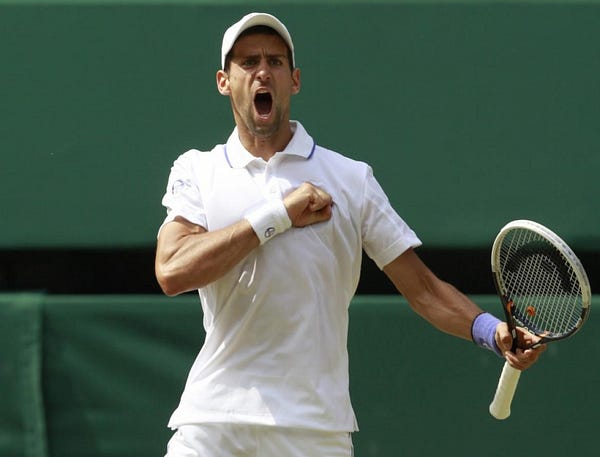

Then
something clicked. Many attribute Djokovic’s breakout 2011 season to a
gluten-free diet and an increased emphasis on conditioning, but there
was something more compelling and unnerving about the way he played the
game. His shot-making was magnificent. His mental toughness exceeded
that of both Federer and Nadal on crucial points. He stretched for every
inch, and seemed to push himself harder than two players that many
considered the greatest of all time. In 2011, he won three of four Grand
Slam tournaments and ascended to World No. 1 for the first time in his
career. Altogether, since the beginning of 2011, Novak Djokovic has
appeared in 15 Grand Slam finals, winning 9 titles, and bringing his
overall total to 10. He has now held the World No.1 spot for 162 weeks,
and has captured eight ATP World Tour Masters 1000 Series titles (and
needs only to win the Cincinnati Open to become the first player to win
all nine). A few elements of his game, including his return of service,
two-handed backhand, and court coverage, are considered by many tennis
experts to be the greatest of all time. Every component of his game is
considered nearly flawless. Tennis coach Nick Bollettieri summarized by
saying, “When you look at match players in the history of tennis, I
don’t believe that anybody can equal everything on the court that
Djokovic does. I don’t think you can find a weakness in his game. His
movement, personality, his return of serve, his serve, excellent touch,
not hesitant in coming to the net, great serve. Overall, almost every
player has a downfall; to me he doesn’t have one. He’s perhaps the best
put-together player that I’ve seen over 60 years.”
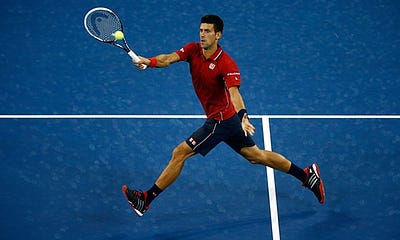

And yet, he remains hated by many in the tennis community, so much so that the the New York Times simply had to ask, “Why can’t Novak Djokovic get some respect?”
The answer, of course, lies within the personal rivalries of the
greatest players of his generation, Roger Federer and Rafael Nadal. As
Djokovic told The Times, “At
the beginning of my career, I was observed as a rebel, somebody who
comes in the mix and starts to challenge the two guys that were so
dominant. ‘Who is this guy from Serbia, small country, comes from
nowhere and starts saying he can beat the top guys and become No. 1?
Obviously, I understand the people’s reaction to that, but I felt that
the only way for me to get out there was to show that I deserved to be
there.”
This
attitude, while making him a stronger competitor, unfortunately landed
Djokovic with a “Lebron complex,” whereby people root against you, not
only because you are currently the best, but because they feel your
success is being measured against a beloved champion of the past. The
only difference in tennis is that the “Michael Jordan” and “Lebron
James” of this scenario have overlapping careers in which they have
played each other 42 times, gotten into shouting matches with each other’s guest boxes in the stands, and generally don’t like each other’s company.
The crowd in Arthur Ashe Stadium during Sunday night’s US Open final
seemed to represent a microcosm of the tennis world, with most
spectators hoping for the Michael Jordan of tennis to defy age and win
that elusive 18th Grand Slam.
Instead,
Djokovic won in 4 sets, in an environment that must have amounted to
the closest thing a tennis player can experience to a road game. And
much to the dismay of the crowd, he did it by simply being a better
tennis player; one who, in 2015, appeared in all four Grand Slam finals,
winning three, while very quietly putting together one of the most
remarkable tennis seasons of the Open Era. At 28 years old, Djokovic is
there; and whether you like it or not, “there” does not simply mean
competing with Federer and Nadal — “There” means stopping legacies in
their tracks, and possibly, dethroning the greatest of all time.
So why should Djokovic be in the conversation for greatest tennis player of all time?
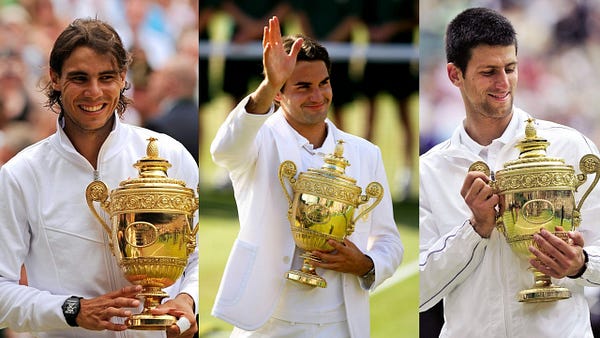

For
starters, we need to shed ourselves of the common notion that simply
holding the most Grand Slam titles makes one the greatest, while holding
the second most makes one the second greatest, and so on. While Grand
Slam titles are still a solid indicator of career success, they’e not
the only indicator. Jimmy Connors, for example, only won 8 Grand Slam
titles (“only” being a very relative term here), but still holds Open
Era records for overall singles titles (109 — still far in first place)
and match wins (1254). Perhaps most famously, Ricardo “Pancho” Gonzalez,
who played before the Open Era (when professionals were not allowed to
play in traditional Grand Slam tournaments) only won 2 Grand Slams
before turning professional, but then won an additional 15 Pro Slams
while being ranked as the World No. 1 for a mind-boggling eight straight
years. While certainly the case for many players before the Open Era,
it is often thought that Pancho Gonzalez in particular would have won
numerous Grand Slam tournaments had he been allowed to compete, with
some estimates as high as 20.
The
point being, we cannot say Federer is best, Nadal is the second best,
and Djokovic is the third best based solely on their Slam counts (17,
14, and 10 respectively), especially while all three are still active
players. There are a myriad of components to look at when considering
the greatest, and their potential for future success is a key element of
that analysis.
For
now, it’s important to note that Novak Djokovic being ranked as the
greatest player of all time is not a new concept. Currently, tennis ELO
rankings, which factor in games, sets, and matches won against the
rankings of a player’s competition to determine the best player at their
peak, have Novak Djokovic in 2015 as the greatest player of all time,
with Federer in 2007 ranked second.


As
you can see, this model is somewhat flawed, as it only seeks to tell us
who the best player was at their absolute peak, without looking at
their career as a whole. This is why a 2009 Juan Martin Del Potro, for
beating Roger Federer in his prime at the US Open, is ranked ahead of
Andre Agassi. Del Potro is a great player and US Open Champion, but few
will argue that the achievements of his career surpass that of Andre
Agassi, arguably the biggest star the sport has ever produced. However,
this is just one model, and it currently ranks Djokovic’s game as the
greatest of all time right now, in this moment. It’s not the most
efficient system, but it shouldn’t be dismissed.
Another
important element of this debate is a player’s competition throughout
their whole career (not just a specific time in their career, which the
model above shows). Andre Agassi, for one, believes Roger Federer,
Rafael Nadal, and Noval Djokovic are the three greatest players ever,
simply because they have to play each other. However, when taking a
close look at their records, this is also the exact reason why I believe
Novak Djokovic is absolutely better than Roger Federer.
Before you throw something at me, let me explain…
While I respect the hell out of Federer, and I do consider him to be one of the top 5 players ever, I am of the opinion that his Grand Slam count is bloated and misleading in the GOAT debate (this is usually the moment when a Federer fan throws a chair at me). To understand this at a basic level, let’s look just at records in Grand Slam finals.
Roger Federer — 27 Finals — Record: 17–10
Rafael Nadal — 20 Finals — Record: 14–6
Novak Djokovic: 18 Finals — Record: 10–8
Roger
Federer has obviously been to and won the most Grand Slam finals, and
that can’t be argued. Nadal has the best win percentage in Grand Slam
finals, though this stat is slightly skewed due to Nadal’s overwhelming
dominance on clay (9 of his 14 wins are at the French Open, and he’s
never lost a final there). Djokovic has the worst win percentage of the
three, though you’ll see why in a moment. Let’s take a look at those
exact same stats after we remove every other player on tour and compare
their finals records just against each other.
Roger Federer — 12 Finals — Record: 3–9
Rafael Nadal — 15 Finals — Record: 10–5
Novak Djokovic: 11 Finals — Record: 6–5
As
you can see, things have changed considerably. Nadal still looks
dominant, having played in the most finals against the other two
opponents, with the most wins and the best win percentage. Djokovic
moves down slightly in this model, though he still maintains a winning
record against the best players of his era.
As
you can see, the player profile that completely changes is that of
Roger Federer. Fed’s Slam final count gets reduced by more than half,
while his record morphs into a losing scenario that is essentially a
blowout. Consider this: All three of his wins against Djokovic or Nadal
came before 2008, meaning he has not beat either player in a Grand Slam
final in eight seasons. One of the arguments people quickly employ to
defend Federer is that he is so much older than Djokovic and Nadal, and
those players are beating up on him in the twilight of his career, but Fed’s struggle against them started when he 26…..
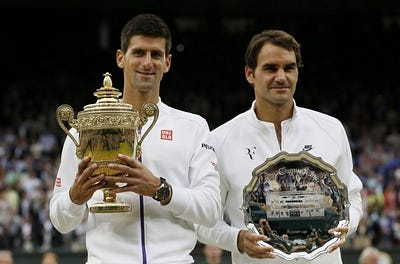
Roger
Federer’s Grand Slam count is bloated and misleading, because he won a
majority of his trophies in a transitional period in tennis when the
competition was weaker. For example, four of his Majors came from wins
over Andy Roddick, who, by his own admission,
is the worst player to ever hold the World No. 1 ranking. In addition,
two more Federer Grand Slam finals were won against players who never
achieved a career high ranking greater than World No. 8 — Mark
Philippoussis at Wimbledon 2003, and Marcos Baghdatis at Australian Open
2006 (and if anyone says they have heard of either of those players,
they’re lying). He defeated Fernando Gonzalez at the 2007 Australian
Open, who never achieved a ranking higher than World No. 5, and whose
primary accomplishment is winning the silver medal at the 2008 Olympics
in Beijing. If we include the 2009 US Open against Juan Martin Del
Potro, which Federer lost, three of the players he faced in Grand Slam
finals literally never made it to another Grand Slam final. His Career
Grand Slam is intact only because he played Robin Soderling in the 2009
French Open final while managing to avoid Nadal, who succumbed to an
injury-induced upset earlier in the tournament. Even his 2005 US Open
title is slightly misleading — He beat Andre Agassi, certainly an all
time great, but one who was 35 years old at the time and would retire
from tennis by the next year.
I’m
not trying to pick on Roger Federer. As is said time and again in all
sports, you have to play the opponent in front of you, and Federer did
that in dominating fashion for years. It’s not his fault that he came of
age during this transitional period, but he did, and the moment his
opponents began to approach his talent level, Federer’s dominance slowly
dwindled. He has now won only one Grand Slam tournament in the last
five years, and has lost his last three finals to Novak Djokovic.

Comparing
Djokovic to Rafael Nadal is a little trickier, and relies more on a
general consensus of where their careers are headed and their potential
for more Grand Slams. I think most will agree, if Djokovic or Nadal had
been facing similar opponents in the early part of their careers as
Roger Federer, their Slam count would far exceed the numbers they are at
now. Instead, they are contemporaries who have played each other
in Grand Slams while fending off the sometimes brilliant Andy Murray
(also 28 years old), who took at least two Slams away from Djokovic when
he was playing at his peak from the Summer Olympics of 2012 to
Wimbledon 2013. Djokovic and Nadal have both also lost a Grand Slam
final to Stan Wawrinka, the 30 year old Swiss who has emerged as a top 5
threat later in his career. If being the greatest truly were about
Grand Slams and Grand Slams only, the road for Nadal and Djokovic has
been much harder.
As
it currently stands on paper, Nadal has the superior resume, so much so
that some analysts, using the argument above about Federer’s weaker
competition, already see Rafael Nadal as the greatest player of all
time. He is second on the Grand Slam list with 14 (tied with Pete
Sampras), and has absolutely dominated Federer from the start. Their
Grand Slam final record is 6–2 in Nadal’s favor, and their overall
record stands at a staggering 23–10 in Nadal’s favor. Putting aside all
arguments about Federer’s early competition, some don’t see Fed as the
greatest of all time because there has been at least one player who has
been consistently better than him his whole career.
Conversely, Nadal and Djokovic are not only evenly matched, but their rivalry has provided the largest sample size of any in the Open Era. They have played each other a record 44 times, with 13 of these matches in Grand Slam tournaments, including 7 Grand Slam finals. Currently, the rivalry dips slightly in Nadal’s favor at 23–21 overall, 9–4 in Grand Slam tournaments, and 4–3 in Grand Slam finals. Their matches produce notoriously high-caliber tennis, with John McEnroe commenting that the 2012 Australian Open final and 2013 French Open semi-final are the greatest matches ever played on a hard court and clay court, respectively.
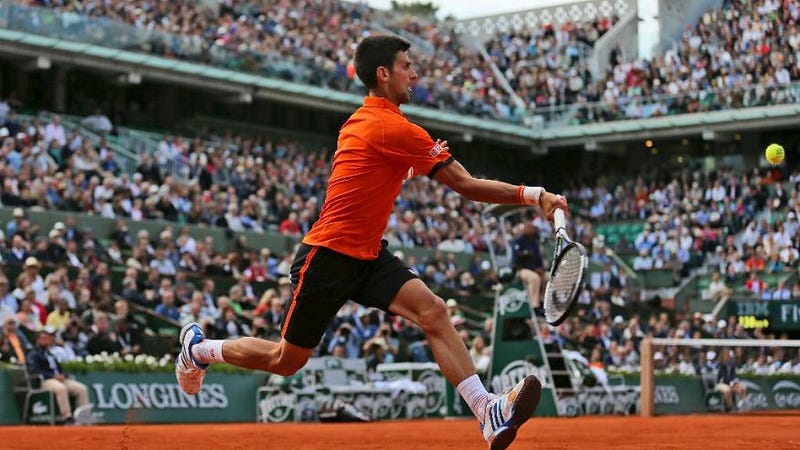
To
consider Djokovic the greatest of all time, he will have to fill a
glaring hole in his resume; one that Rafael Nadal has almost single
handily prevented — The French Open, and by extension, the Career Grand
Slam. 7 of the 13 Nadal-Djokovic Grand Slam meetings have been at the
French Open, where Nadal maintains a lopsided record, 6–1. Nadal, of
course, is the greatest clay court player in history, has won 9 titles
at Roland Garros, and lost only two matches at the tournament his whole
career. However, one of those two matches was his last one in 2015,
which he lost to Novak Djokovic.
The
greatest hurdle to Djokovic’s argument for GOAT is beating Nadal at the
French Open and winning the title. He completed step one in 2015, but
still lost in the final to Stan Wawrinka. Djokovic though, is the best clay court player in the world right now,
and if he can start consistently beating Nadal on clay, which he has
shown he can do, there is no doubt he will eventually capture the title
at Roland Garros.
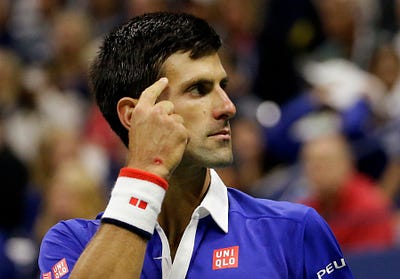
Ultimately,
the entire argument for Djokovic’s greatness falls squarely on his
potential as a tennis player and athlete, as well as the current status
of his best competition. Roger Federer, though playing remarkably this
late in his career, is likely going to age out of the sport, and
Djokovic has shown plainly that he can consistently beat Federer when it
matters most at this point in their careers. Nadal, on the other hand,
has a history of injury-proneness that is well documented (There are
literally too many articles to link to for this; just google “Nadal
injury-prone”). Many have argued that his aggressive style of play will
weaken his body over time, and his career will not maintain the
longevity of his opponents — an occurrence we are already watching. He
did not win a Grand Slam in 2015 (his first year without a Grand Slam
win since 2004), and his ranking has slipped to World No. 8.
Meanwhile, Djokovic has maintained a reputation as the fittest athlete in the world.
Though Nadal found earlier success, especially on clay courts, his body
seems to be giving out at the same time that Djokovic is finding new
levels of energy. In 2015, he handed Nadal his second loss at the French
Open, beat Federer in two Grand Slam finals, and was one win away from a
Calender Grand Slam. His ATP points are so high that he could literally
skip the entire fall indoor hard court season and still finish the year
as World No. 1. Though a Calender Golden Slam seems unfathomable in
today’s game, Djokovic will likely be the number 1 seed in every
tournament he plays next year. If Nadal’s career slide continues,
Djokovic will be the overwhelming favorite for all four Grand Slam
tournaments, plus the Olympics in Rio de Janeiro.
So, now we play the hypothetical game…..
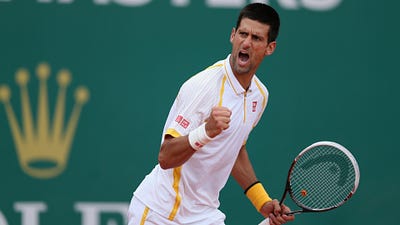

Let’s assume, as many tennis analysts do,
that Roger Federer is done winning Grand Slams, and his record mark
will remain at 17. As I’ve argued, I think that number is misleading,
and in my mind Djokovic doesn’t have to better it to be considered the
greatest ever, but let’s say that’s his goal. Some have asked if Nadal
is also done, but for the sake of argument, let’s assume he wins 2–3
more and possibly equals Federer’s mark. That means Djokovic has to win 8
more Slams and hold a World No. 1 ranking for approximately 140 more
weeks to pass Federer (he has already held the World No. 1 spot longer
than Nadal). To do this, Djokovic needs to win two slams a year for four
more years, until he is 32. That seems plausible, but as Federer has
shown, even great players can have a dramatic drop-off after 30. While I
do think Djokovic is in better shape and will be able to play at a
higher level longer, I think he will need to accumulate the bulk of
these Slams in the next two years. In that case, he’ll need to win 3
Slams a year for the next two years, and then just win two more slams
after 30. At the level he is currently playing, it’s not hard to imagine
him doing just that; but asking someone to win three Grand Slam
tournaments a year for three straight years (including his completed
2015 season) is a lot to put on someone, even the best player in the
world.
There
are a few other things Djokovic can do during this time to earn the
title of “Greatest of all time.” He has already beaten the greatest clay
court player ever at the French Open, which Federer could never do. If
he wins the 2016 French Open, that will make him the 8th man in history
to capture the Career Grand Slam, and just the fourth to do so on three
different surfaces (along with Agassi, Nadal, and Federer). If he can
follow that up with a win at the 2016 Summer Olympics, that will give
him the Career Golden Slam, which Federer never achieved. At that point,
depending on what happens at Wimbledon and the Australian Open, he
could have 11–13 Grand Slam titles, plus the Career Golden Slam.
From
there, it becomes a matter of just how high he can go. If he wins two
French Opens, that will give him the Career Double Slam (winning all
fours Grand Slam tournaments at least twice), which hasn’t been
accomplished since Rod Laver completed his Double Slam in 1969. Assuming
he continues to win at his 2015 rate, and his World No.1 ranking
remains intact, it’s not outrageous to discuss the possibilities of a
Career Grand Slam, a Career Golden Slam, or a Career Double Slam,
(though highly unlikely, if he accomplishes a Calendar Golden Slam in 2016, I’ll call him the greatest player of all time with no hesitation).

The
beautiful thing about tennis is that nothing is guaranteed, and
probably the greatest aspect of the Federer-Nadal-Djokovic “trivalry” is
that any one of them can beat the other on any given day. Last month,
at the Cincinnati Open, I watched in person as Roger Federer walked over
the competition and demolished Novak Djokovic in the final without
allowing the greatest service returner in history a break point. At the
time, it seemed like Federer had found a new level and simply couldn’t
be beat. Then he ran into Djokovic again.
Novak
Djokovic could sustain an injury; he could lose his focus; he could go
through personal issues, or just plain lack the motivation to do the
things I’ve discussed. Rafael Nadal could experience a career resurgence
and show us all how dominate he once was. Andy Murray could reignite
his desire and challenge them both while increasing his own Slam count.
Other top 10 threats could rise to the occasion and pull upsets — David
Ferrer, Tomas Berdych, Juan Martin Del Potro, Jo-Wilfried Tsonga — all
Grand Slam finalists who are more than capable of winning big matches.
And yes, until he retires, there is no one on Earth who believes that
Roger Federer doesn’t have it in him to win one more Grand Slam.
Novak
Djokovic doesn’t get the respect he deserves, and for now, he seems to
be okay with that. But as soon as one year from today, there could be a
major shift in the GOAT debate, and the crowds of Arthur Ashe stadium
may find themselves regretting their contempt for a man who has already
altered the history of tennis . After Djokovic was accused of faking
injuries early in his career, Roger Federer publicly stated, “I think he’s a joke.”
That “joke” has now actively halted Roger Federer’s legacy-building,
and has made it clear he has the talent to make history of his own.
In the end, the Djoker just might have the last laugh…
Nate Carter
 Craig O'Shannessy
Craig O'Shannessy


